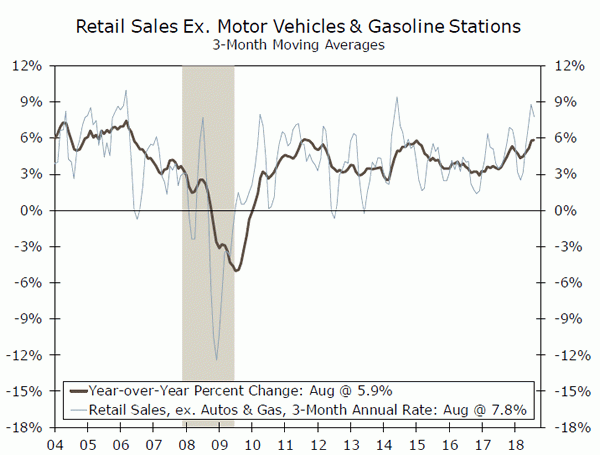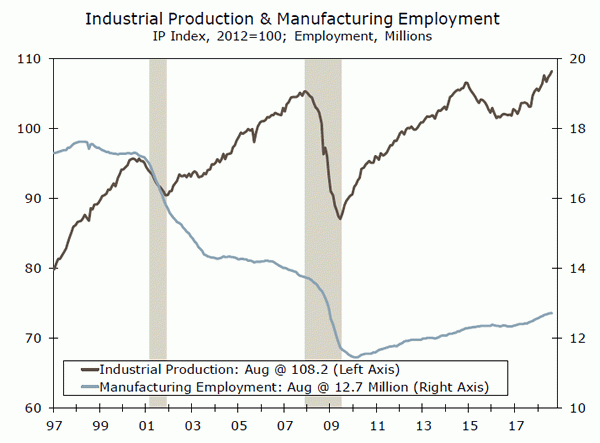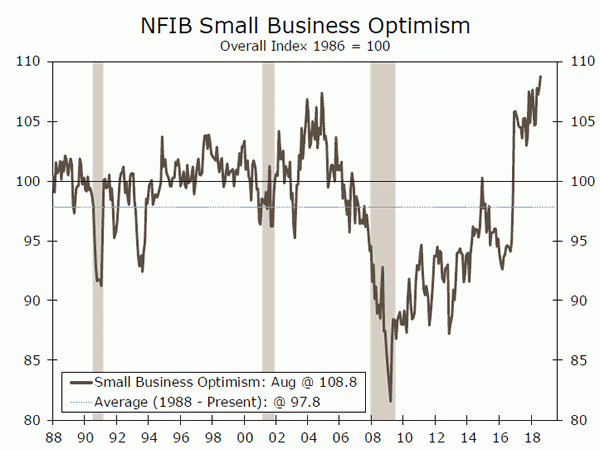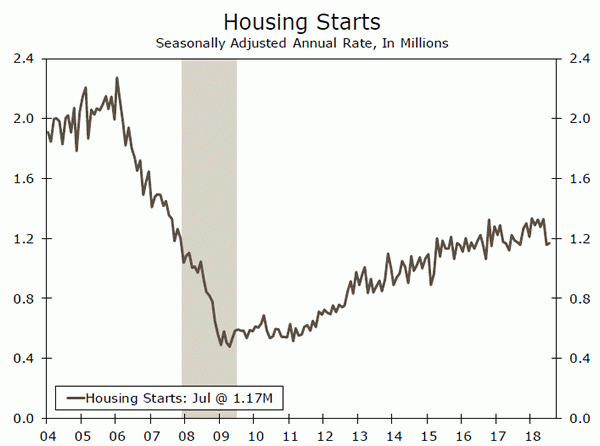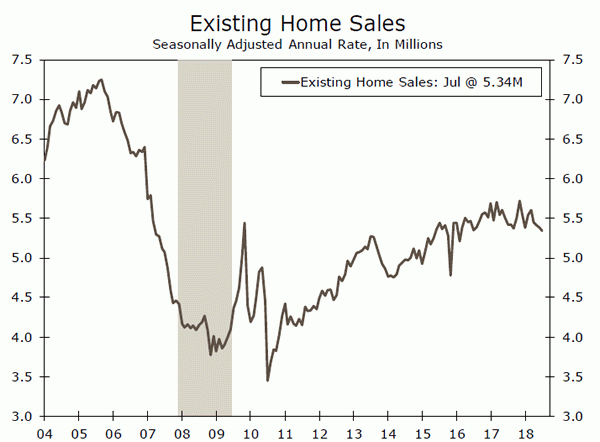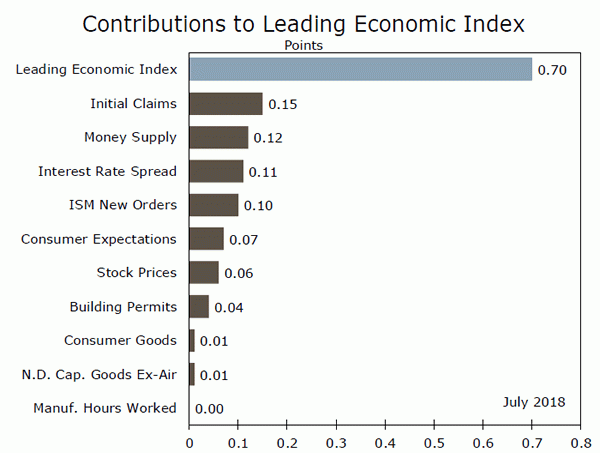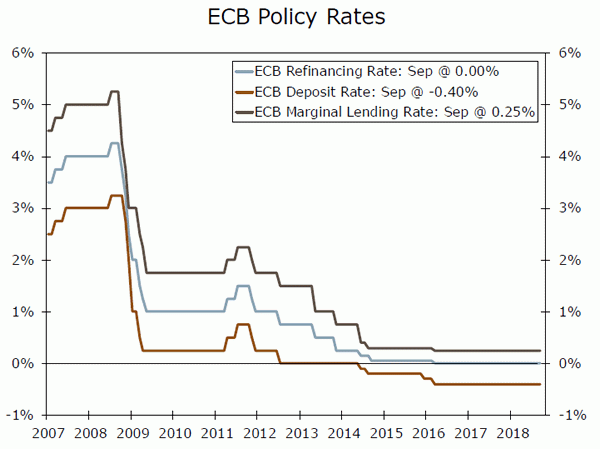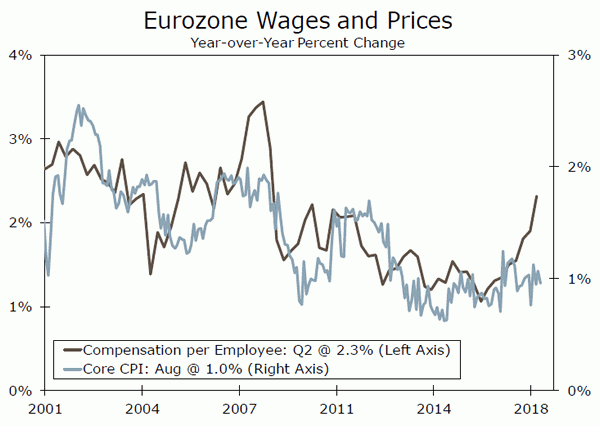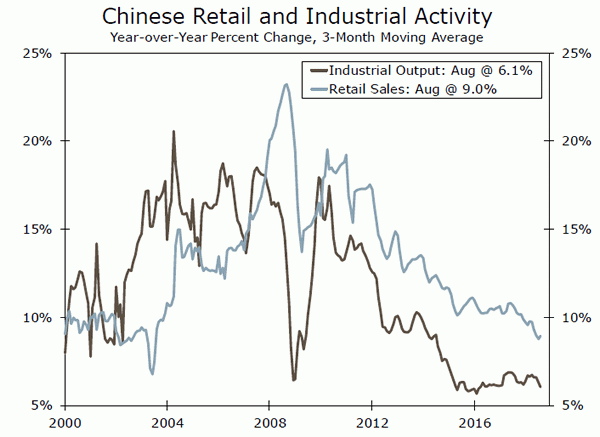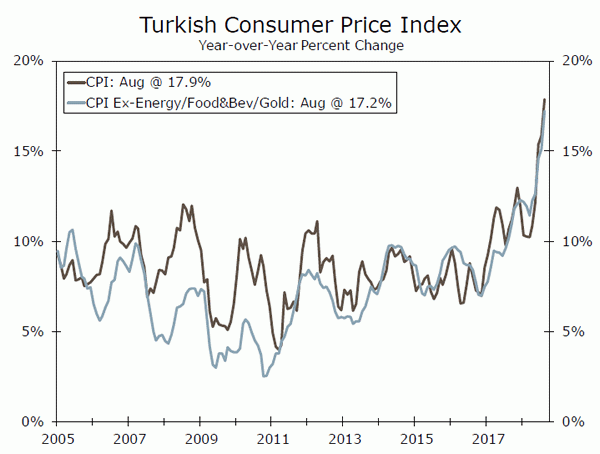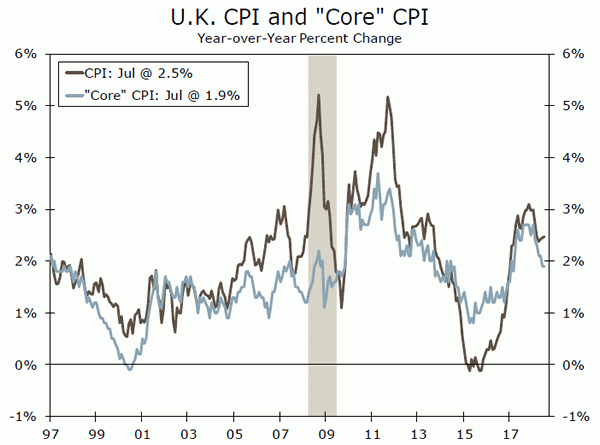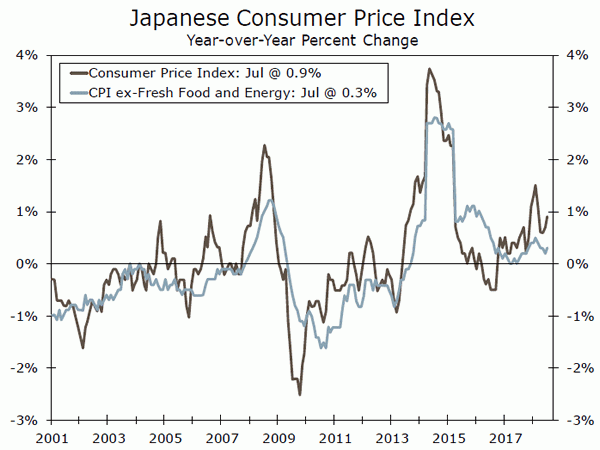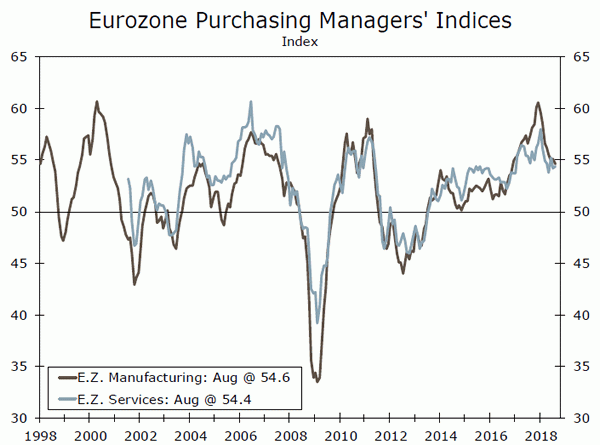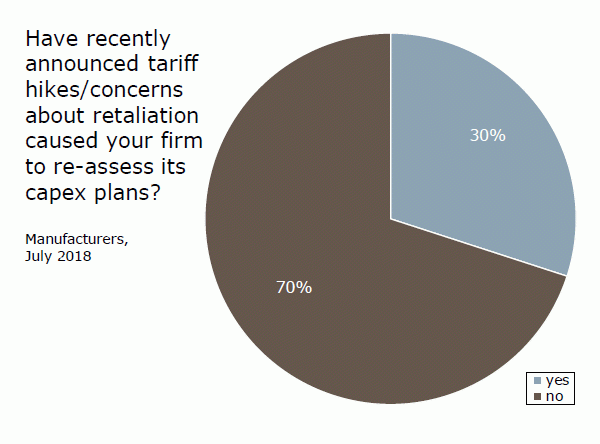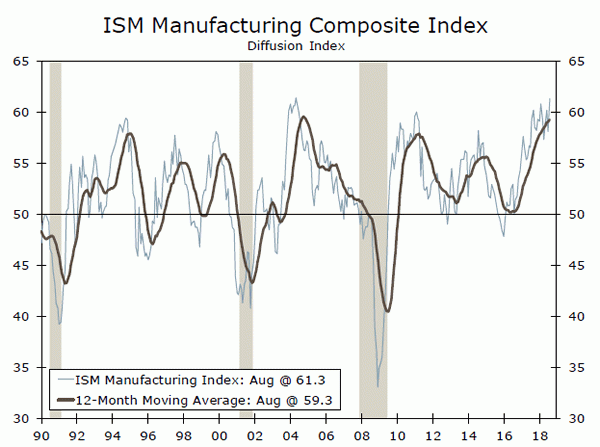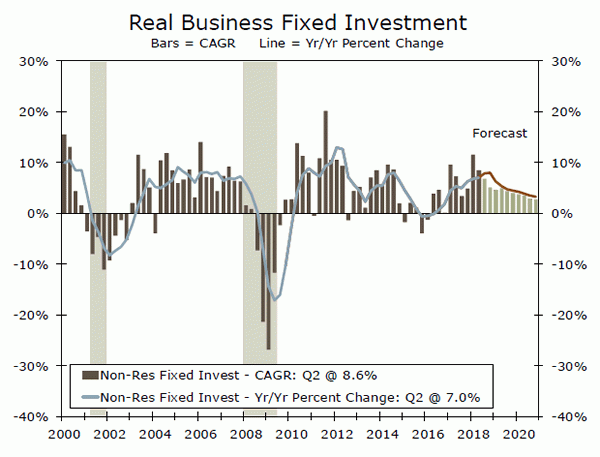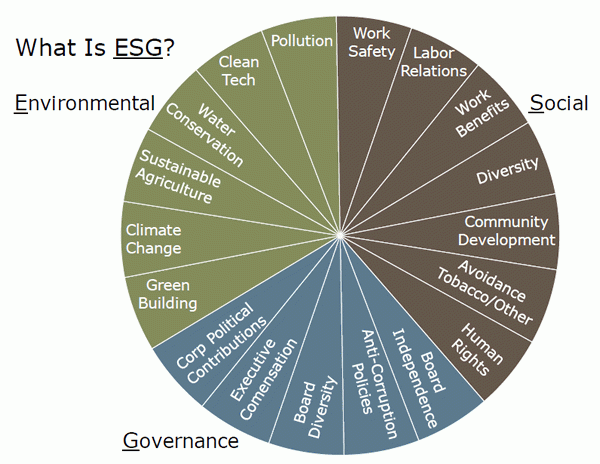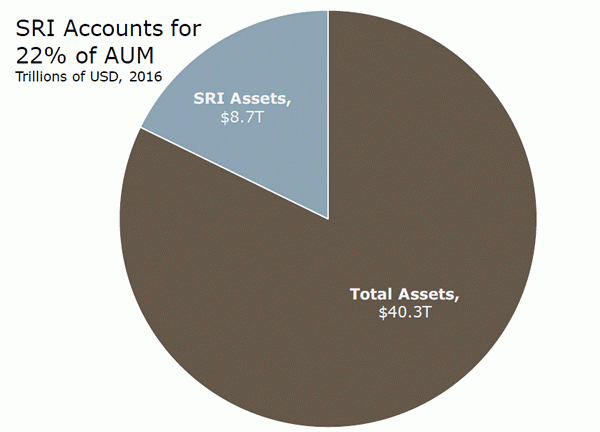U.S. Review
Growth Remains On Pace With Little Sign of Overheating
- The inflation data took center stage this week. The CPI and PPI both came in slightly below expectations and inflation expectations remain well anchored. Import prices also fell more than expected during the month.
- The NFIB Small Business Optimism Index rose to an all-time high in August, climbing 0.9 points to 108.8.
- Retail sales rose less than expected in August, rising just 0.1% overall. The prior month’s data were revised higher, however, and consumer spending remains solidly on pace with our forecast for the third quarter.
US Growth Remains on Track
This past week’s economic reports largely came in close to expectations and suggest third quarter real GDP growth will rise close to our expectations of a solid 3.1% annual rate. Most of the key economic data came at the end of the week. Retail sales data came in a bit light, rising just 0.1%, but data for the prior month were revised higher and the core measure of retail sales remains up at a brisk 7.8% pace over the past 3 months (top chart).
Keep an eye on clothing and department store sales, which tumbled 1.7% and 1.0%, respectively in August. Back-to-school sales have historically been a good predictor of holiday season sales and the weakness here is somewhat surprising. These categories are notoriously volatile, however, and calendar effects can cause wide month-to-month swings. Much of the most recent drop appears to have been due to discounting. Apparel prices tumbled 1.6% in August, their largest monthly drop since January 1949.
Industrial production rose 0.4% in August, which was slightly better than expected. A rebound in motor vehicle assemblies and utilities output accounted for most of the increase. Motor vehicle output jumped 4.0% in August following a 1.4% drop the prior month. Excluding motor vehicles and parts, manufacturing output was unchanged in August, following a 0.5% rise the prior month. Utility output jumped 1.2% in August, with electric utilities logging all the increase, reflecting warmer temperatures and increased use of air conditioning.
The inflation data largely came in below expectations. The headline PPI fell 0.1% in August after remaining unchanged in July. The year-to-year change in the final demand series fell on both an overall and core basis, slipping to 2.8% and 2.3% respectively. While it is hard to draw too many conclusions from the PPI data, it appears that inflationary pressures are cresting or possibly even backtracking a bit, likely due to some slowing in global economic conditions. Price increases have also eased at the intermediate level and the old method of measuring the PPI, which is much more closely tied to industrial demand, shows both headline and core inflation pressures easing.
Both the headline and core CPI measures came below expectations, rising 0.2% and 0.1% respectively in August. The year-to-year measures in both eased slightly, with the overall CPI moderating to 2.7% from 2.9% percent a month earlier and core sliding back to 2.2% year-over-year from 2.4% in July. The smaller rise in the core CPI was largely due to the previously mentioned plunge in apparel prices. Given the lack of recent precedence for such a plunge, this looks more structural than cyclical and its moderating impact on the headline and core CPI data is unlikely to impact the Fed’s timetable for raising interest rates.
The National Federation of Independent Business (NFIB) Small Business Optimism index rose to a new all-time high in August (bottom chart). Business owners continue to express a great deal of optimism about the economy and their business, which adds a little upside risks to forecasts for business fixed investment and employment.
U.S. Outlook
Housing Starts • Wednesday
Housing starts increased slightly in July. The number of new units started during the month rose 0.9% to a 1.168-million unit pace, an unspectacular, yet solid gain. Both single family and multifamily starts edged higher, growing 0.9% and 0.7%, respectively. While July’s reading came in under expectations, total starts are now running 6.2% ahead of last year on a year-to-date basis.
Despite new starts falling somewhat short of expectations, builders continue to report strong buyer demand. Rising labor and material costs have been a major headwind to homebuilding this year, causing projects to be delayed or cancelled entirely as they no longer pencil out. However, material prices tend to be lower in the second half of the year, which should allow some of the stalled projects to restart. Our expectations for new residential building have been scaled back recently due to these mounting cost pressures, but we still anticipate new housing starts to trend higher in coming months.
Previous: 1,168K Wells Fargo: 1,221K Consensus: 1,231K (SAAR)
Existing Home Sales • Thursday
Existing home sales fell in July. Resales of single family homes and condo and co-ops dropped 0.7% to a 5.34-million unit pace during the month, and are now 1.5% below year-ago levels. Excluding condo resales, existing single family homes fared slightly better and only registered a 0.2% decline. The lack of inventory is keeping home prices elevated and restraining sales. Total inventory declined 0.5% during the month, while the month’s supply of homes on the market held constant at 4.3 months.
Existing home sales remain stuck in low gear, and affordability is an increasing concern. Mortgage rates have ticked higher the past year, and continued low levels of inventory on the market have translated to home prices rising well ahead of income growth. Still, signs continue to point to economic growth remaining solid headed into the fall, which should allow existing home sales to pick up from their current pace.
Previous: 5.34M Wells Fargo: 5.39M Consensus: 5.38M (SAAR)
Leading Index • Thursday
The Leading Economic Index (LEI) increased 0.6% in the July, further evidence that economic growth should remain solid in the second half of 2018. The monthly gain follows a 0.5% rise in June and has now climbed 5.5% on a six-month annualized basis. July’s improvement was also comprehensive, as each of the underlying components contributed to the 0.7 point increase in the headline index. The largest contributor was initial jobless claims, which added 0.15 points. Meanwhile, manufacturing hours worked had the smallest impact and remained neutral to the overall index.
Several components of the index continued be solid in August. Initial jobless claims fell to new lows, while ISM new orders showed a substantial gain. We expect the LEI to continue to advance and point to the economy maintaining strong momentum throughout the second half of the year.
Previous: 0.6% Wells Fargo: 0.5% Consensus: 0.5% (Month-over-Month)
Global Review
ECB Leaves Rates Unchanged, EM Remains in Focus
- Several central bank announcements were slated for release this week, including the European Central Bank (ECB), which left policy unchanged. We look for the ECB to maintain a slowand- steady approach to removing policy accommodation, as inflationary pressures remain muted.
- Economic data released in China this week showed steady retail and firmer industrial activity growth, as that country’s central bank pauses along its deleveraging path.
- Turkey’s central bank notably raised interest rates 625 bps to 24%, higher than consensus estimates, in an attempt to curb rampant inflation and rapid depreciation of the Turkish lira.
ECB Leaves Rates Unchanged, EM Remains in Focus
It was a busy week across the international arena, with several central bank announcements and data releases of note. In the Eurozone, the European Central Bank (ECB) left policy unchanged (see chart on first page), and confirmed its plan to taper asset purchases to €15 billion per month in October before wrapping up its bond-buying program at the end of 2018. However, it also reinforced that this timeline remains conditional on incoming data in the months ahead.
This week’s decision largely reinforces our view that the ECB will adopt a slow-and-steady approach to winding down policy accommodation. The ECB has signaled that it must first end asset purchases before raising interest rates, and we do not see its first rate hike occurring until fall 2019. In the accompanying press conference, ECB President Draghi noted that while inflation currently remains muted, underlying inflationary pressures have picked up. Indeed, data released this week showed that wage growth reached 2.2% year-over-year in Q2, up from 2.1% in Q1 (top chart). While core inflation remains stuck around 1%, the Q2 pickup in compensation is a positive sign for rising price pressures going forward as wage growth picks up.
That said, the ECB also downgraded its economic forecasts slightly for 2018 and 2019, with President Draghi citing a somewhat weaker contribution to GDP growth from external demand. While the economic expansion generally remains solid, trade tensions remain on the forefront. President Draghi cited rising protectionism as a risk to its outlook, a factor that that could also weigh on export growth in coming quarters.
Shifting to emerging markets (EM), Chinese data released this week showed that economic conditions generally remained solid in August. Growth in retail sales firmed to 9% year-over-year and industrial production growth was also stronger (middle chart). The People’s Bank of China (PBoC) has paused its deleveraging process in recent months, cutting its reserve requirement ratio for commercial banks in an attempt to inject more liquidity into the market. Even with slightly softer year-to-date fixed investment spending, there are some promising signs of stronger growth prospects for the economy. Ongoing trade tensions remain an area to watch, as the Trump administration continues to discuss imposing additional tariffs on a variety of Chinese goods in coming weeks.
Elsewhere in EM, Turkey remained in focus, with its central bank raising interest rates 625 bps to 24%, higher than market estimates. Turkey has captured headlines recently amid fears of financial market contagion, as the Turkish lira has slid almost 40% against the dollar so far this year. Market participants remain concerned about Turkey’s high current account deficit, while inflation has also skyrocketed to nearly 18% in August (bottom chart). Although the lira remains under pressure, it recovered around 4% against the dollar after the central bank announcement. Given rampant inflation and the lira’s downward spiral, the central bank could raise rates further in coming months.
Global Outlook
U.K. CPI • Wednesday
Inflation in the United Kingdom has been on a downward trend after surpassing 3% in the wake of the Brexit Referendum in 2016, as a sharp drop in sterling caused price pressures to surge. Headline CPI rose 2.5% in August year over year, and core CPI remained below 2%. Retail sales data for the U.K. will also be released next week and should give further detail on the outlook for the consumer sector. Growth in retail sales has picked up in recent months as price pressures have eased, after sales slowed through the end of 2017.
While inflation has started to come back down to earth and retail sales have firmed, economic growth in the U.K. has remained sluggish, with real GDP rising 1.5% annualized in Q2. Given slower economic growth and ongoing Brexit negotiations, we look for the Bank of England (BoE) to remain on hold in coming quarters until these concerns subside.
Previous: 2.5% Wells Fargo: 2.4% Consensus: 2.4% (Month-over-Month)
Bank of Japan Decision • Wednesday
At its July meeting, the Bank of Japan (BoJ) adjusted policy slightly by widening its 10-year government bond yield tolerance band and changing some commercial bank deposit requirements. Despite these minor policy adjustments, the BoJ remains firmly in accommodative territory. The BoJ also introduced dovish forward guidance at its last meeting, stating that interest rates will remain low for an extended period of time.
Data released since July showed that GDP growth in Japan rebounded in Q2 after slipping into negative territory in Q1, however inflation remains below 1%. Given subdued inflation data and the policy changes already introduced at its July meeting, we look for the BoJ to remain on hold next week. In other central bank announcements slated for release, the Swiss National Bank is expected hold policy steady, while the consensus looks for the Central Bank of Norway to raise its deposit rate to 0.75%.
Previous: -0.10% Wells Fargo: -0.10%
Eurozone PMIs • Friday
After displaying mixed results in August, markets will be closely watching the preliminary September release of the Eurozone Purchasing Managers’ Indices (PMI) next week. In August, the manufacturing PMI missed consensus expectations and slipped slightly to 54.6 percent, while the services PMI rose to 54.4. Services represent a large share of the Eurozone economy, so the uptick last month could be a positive signal for strengthening overall economic growth if the trend continues in coming months.
For now, subdued GDP growth in the Eurozone this year has supported the ECB’s continued accommodative monetary policy stance. The ECB has signaled that it must first wrap up its bondbuying program at the end of this year before hiking rates, and we do not look for it to start raising interest rates until fall 2019. In the meantime, policymakers will likely be watching next week’s PMI releases closely for signs of a possible pickup in economic growth.
Previous: 54.6 (Manufacturing), 54.4 (Services) Consensus: 54.4 (Manufacturing), 54.4 (Services)
Point of View
Interest Rate Watch
Bostic: Tariff Concerns and Capex
On Thursday, Federal Reserve Bank of Atlanta President Raphel Bostic presented to the Mississippi Council on assessing the impact of international trade on firms’ investment plans. His address serves as another example of the ongoing tariff debate continuing to capture the attention of policymakers and markets alike.
With roughly 28% of U.S. GDP linked to the international trade of goods and services, Bostic argues that foreign trade linkages are complex and not readily transparent. As firms’ continue to rely on the global supply chain, the challenge of interpreting the broad implication of tariffs on the U.S. economy only intensifies when trying to account for the expectations of firms.
Bostic points to the Survey of Business Uncertainty, which attempts to gauge firm’s expectations regarding their capex, sales, employment and costs. One-fifth of firms surveyed said they are reassessing their capex plans in July due to tariff related concerns, while only 6% reported actually cutting spending.
However, as Bostic highlights, “there are reasons for concern…30% of manufacturing firms report they are reassessing their capital expenditure plans because of tariff worries, and manufacturing is highly capital intensive,” (top chart) while, “12% of the firms report they have placed previously planned capital expenditures under review”. With trade tensions only escalating, there is scope for continued uncertainty in capex spending.
Looking toward the latest ISM report, however, may suggest otherwise. Contacts made numerous mentions of tariffs in the August ISM report, but with the overall index strengthening to its highest reading in 14 years, trade has not appeared to faze activity (middle chart). Despite the ISM current production index posting a solid gain in August, investment plans say more about a firms expectations than they do about current conditions. While trade tensions have yet to show up in the hard data, we expect investment spending to moderate in Q3 from the robust pace of spending seen in the first half of the year (bottom chart).
Credit Market Insights
Credit Markets and the Real Economy
With tomorrow marking the tenth anniversary of the Lehman Brothers Chapter 11 bankruptcy filing, there has been renewed reflection on the causes and consequences of the Great Recession. Former Fed Chair Ben Bernanke added his voice to the conversation this week, with a paper exploring the mechanisms by which financial distress led to such a severe economic contraction. He discusses two major frameworks of understanding the path of the recession—one in which the collapse in housing prices led to a major pullback in household spending, and another in which the massive losses in securitized product markets set off a broader financial panic and “credit crunch”.
Bernanke argues that the factors associated with a “credit crunch” are better able to explain such a broad economic contraction than the factors associated with household deleveraging and a consumer spending collapse. However, he explicitly recognizes that these two explanations are not mutually exclusive; clearly, household financial health and the strength of credit markets are intricately related. A conclusion about the relative importance of these two explanations is beyond the scope of this column, but Bernanke makes another, arguably more important conclusion—the need for greater attention to credit market dynamics in macroeconomics. Indeed, as this expansion approaches the longest on record and some imbalances begin to build, it is essential to monitor credit markets for insights into the real economy.
Topic of the Week
Value in Virtue: Impact Investing & the Economy
While the purpose of investing is to maximize returns, the allocation of capital also shapes corporate behavior, and that has implications for the economy. Capital that is deployed with consideration to factors beyond just financial returns, like contributing to a positive difference in the world, is known as impact investing. This type of investment has also come to be recognized as socially responsible investing (SRI) or ESG investing, which specifically refers to firms that exhibit a commitment to Environment, Social and Governance values (top chart).
While it is true that not every investor will be willing to place value on non-financial returns on investment, even financially motivated market participants will not want to overlook the fact that this fast-growing category of investment captures roughly 20 cents of every dollar invested (bottom chart). The fact that this category is gaining traction and capturing asset flows suggests that it will influence corporate decisions, and that translates into implications for the economy.
The current economic landscape offers a compelling backdrop for the impact part of impact investing to be manifested. Our recent report looks into how ESG values could shape corporate behavior, and what that means for three areas of the economy: the labor market, consumer spending and prices.
The labor market is as tight as it has been in decades and wage pressures are building, which affords businesses the opportunity to better align their priorities with what today’s workers value to attract the best–and increasingly scare–talent. Meanwhile, consumers’ growing preference for values-based purchases has businesses changing up what is on-offer. Organic and fair-trade options at the grocery store are growing substantially faster than conventional food, while corporations who are prioritizing more than just profits are gaining market share. Not only are these companies differentiating themselves, but profits need not suffer; consumers are increasingly willing to pay up for goods and services from companies that are more committed to environmental, social and governance principles.





